Winners of the 2013 Burnham Prize Competition: NEXT STOP-Designing Chicago BRT Stations
By Bustler Editors|
Monday, Jun 17, 2013

Related
The Chicago Architectural Club and the Chicago Architecture Foundation recently announced the winners of the 2013 Burnham Prize Competition - NEXT STOP: Designing Chicago BRT Stations.
Archived live stream of the NEXT STOP winners announcement on June 6th at the Chicago Architectural Foundation
An exhibition of winning designs and all competition entries is currently on view at the Chicago Architecture Foundation’s Atrium gallery (224 S Michigan Ave - map) until June 28.
Forty-two entries were submitted to NEXT STOP, representing design teams from 14 countries. The NEXT STOP competition challenged designers worldwide to propose a vision for iconic, functional and sustainable stations for Chicago’s planned Bus Rapid Transit (BRT) system. Each competition entry includes a station prototype and variations for three neighborhoods—the Loop, Bucktown-Logan Square and Pilsen.
The competition was presented by the Chicago Architectural Club and the Chicago Architecture Foundation in partnership with the Chicago BRT Steering Committee, the Chicago Department of Transportation and the Chicago Transit Authority, with support from The Rockefeller Foundation and The Chicago Community Trust.
The competition jury included: Monica Chadha (Converge:Exchange), Gordon Gill (Adrian Smith + Gordon Gill Architecture), Cheri Heramb (AECOM), Gabe Klein, (Chicago Department of Transportation), Pat Natke (UrbanWorks Architecture), Peter Osler (Illinois Institute of Technology), Carol Ross Barney (Ross Barney Architects), Rebekah Scheinfeld (Chicago Transit Authority), Charles Smith (Cannon Design), and Stanley Tigerman (Tigerman McCurry Architecture).
These are the competition winners:
First Place: Form vs. Uniform: Generative Chicago BRT Stations
Hesam T. Rostami and Bahareh Atash from Toronto
Form vs. Uniform incorporates a simple wood surface, which allows BRT stations to be consistent yet unique to their surroundings. Wood strips form the station structure, roof, and entrances. The width and pattern of the wooden strips vary in order to block summer sun. Glass walls provide shelter and views. Rooftop windows let in fresh air. Solar panels generate a portion of the power needed to operate station features including ticket machines, sliding doors, and real time arrival screens. Station amenities include heat lamps and bike racks.
Judges commented: “The FIRST PLACE winners have developed a beautiful station design that combines classic materials with state-of-the art technology to create a new iconic look for a BRT system in Chicago. The design has a timeless quality and simple elegance. It has good integration of structure, seating and enclosure, is easily adapted for varying entry needs and could shelter bikes, as well as people.” - read more
Second Place: Enthalpy
Goi Artetxe and Elise Katherine Renwick from Chicago
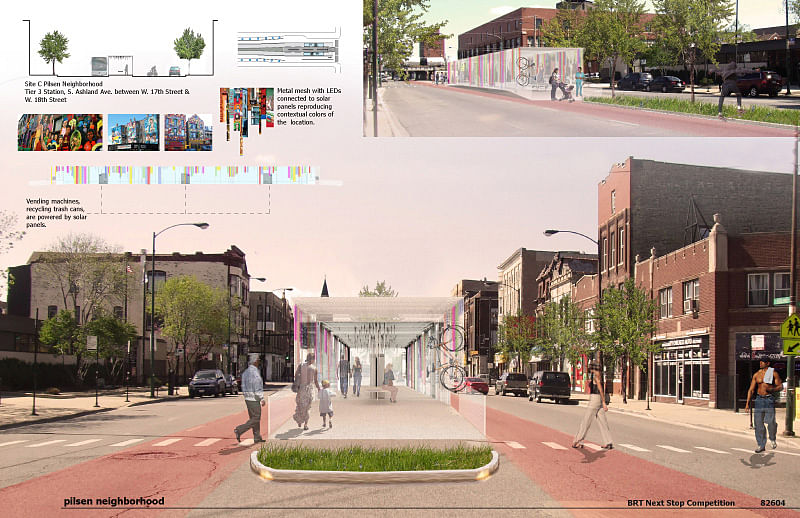
Enthalpy stations serve the community as well as BRT riders. (Enthalpy means the measure of total energy of a thermodynamic system.) The stations incorporate solar panels to generate energy, which powers the stations or returns to the grid. The structures include bike storage, recycling points, ticketing machines, and seating. Vending machines offer bike accessories and snacks. The stations are clad in metal mesh.
Judges commented: “The design for the SECOND PLACE winner creates an inviting space with a feeling of openness that does not overwhelm the street context, and successfully integrates solar and digital technologies.” - read more
Third Place: BTA
Conor O'Shea and Aneesha Dharwadker from Boston

Bus Transit Authority, BTA, is a framework that can adapt to the city and neighborhood scale. Modular units can be arranged as local conditions demand. The flexibility and low cost of BTA components allow for stations to changed based on fluctuating economic conditions, neighborhood development, and seasonal ridership. Stations can be assembled and disassembled for one-off occasions such as sporting events or political rallies.
Judges commented saying: “The THIRD PLACE winners have proposed a station design with a modern look that works across the city, downtown or in the neighborhoods, day and night, and can be sized to fit the right scale needed for each stop with fully integrated digital technology for customer information.” - read more
Following are the three Honorable Mentions and three Citations:
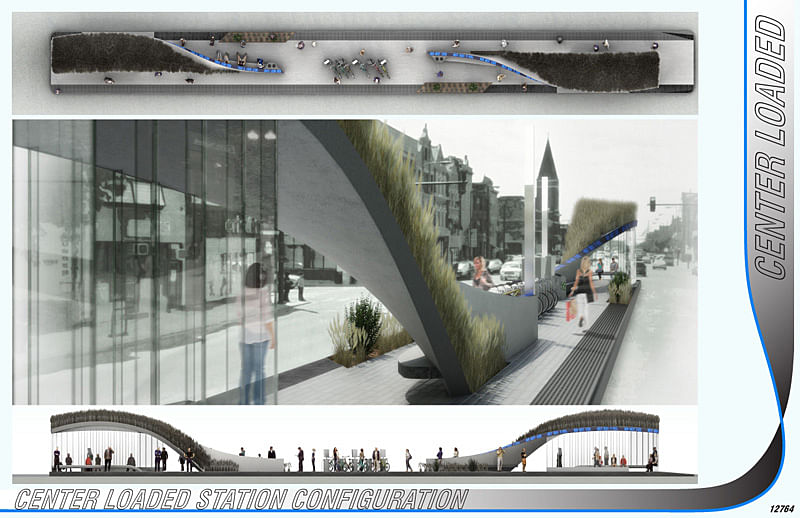

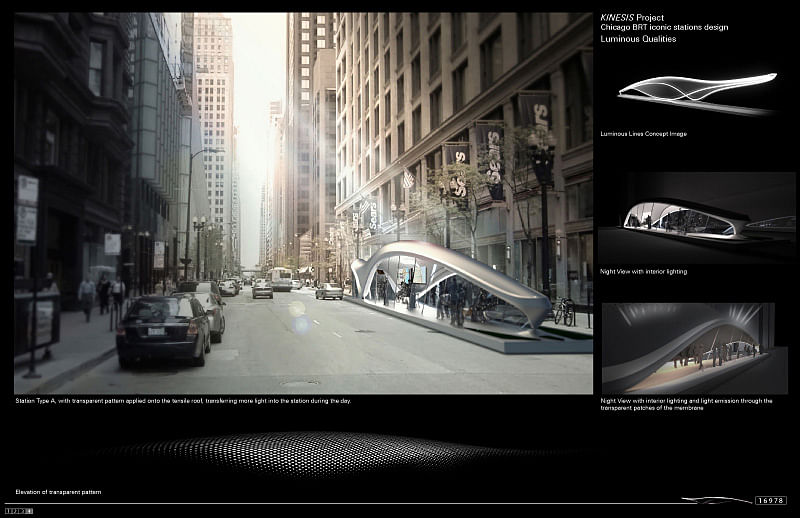
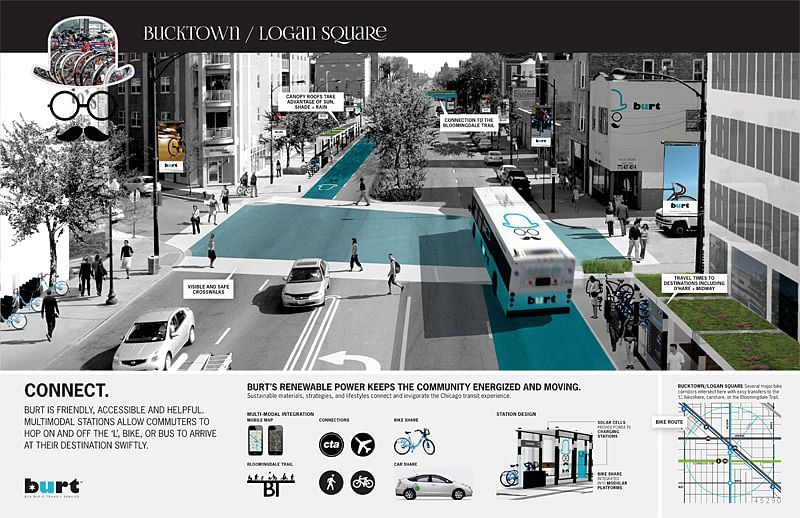
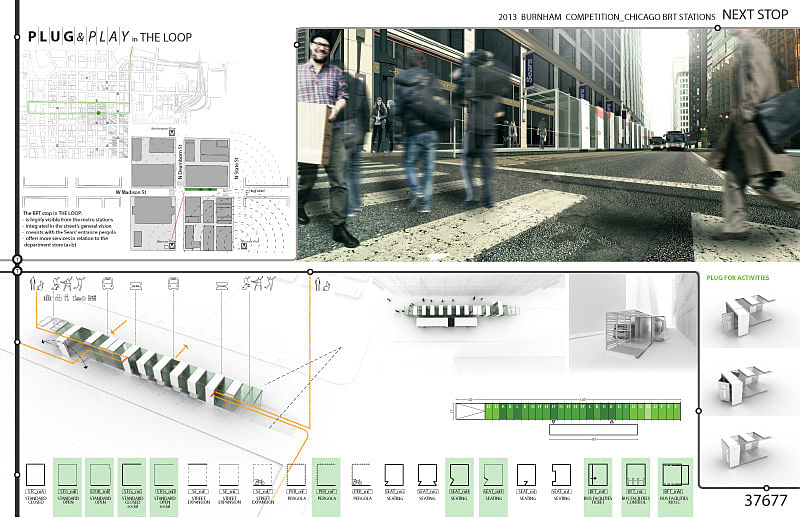

Click here to learn more about these entries.
Commenting on the importance of ideas competitions to urban design, Chicago Architectural Club co-President Brian Strawn stated, "These visionary designs have come from the ground up, directly from the design and architecture community itself.” Added co-President Karla Sierralta, “This competition process should be used as a model to create a better designed Chicago, by sourcing the best ideas from around the globe and directly from our local community."
According to Chicago Architecture Foundation CEO Lynn Osmond, the design ideas submitted represent an innovative vision for the transit station of the future. “Visionary and functional, these designs much more than bus stops,” Osmond said. “We believe the ideas presented here can and should inform the future of BRT in Chicago.”
“The more we looked at the design schemes,” noted Chicago Department of Transportation Commissioner Gabe Klein, who served on the competition jury, “the more I was reminded that we aren’t just creating a transportation system - we’re creating place with these stations. And we’re reinventing the street.”
"A Bus Rapid Transit station isn't just a way to access transit," said Chris Ziemann, Chicago BRT Project Manager. "It's the rider's first experience with this new mode. The form and shape of the station will ultimately influence public acceptance of BRT in the City."

Share
0 Comments
Comment as :